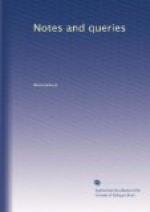* * * * *
Captivity of the queen of Bruce in England.
I perceive, in one of the recent interesting communications made to the “Notes and queries,” by the Rev. Lambert B. Larking, that he has given, from a wardrobe roll in the Surrenden collection, a couple of extracts, which show that Bruce’s Queen was in 1314 in the custody of the Abbess of Barking. To that gentleman our thanks are due for the selection of documents which had escaped the careful researches of Lysons, and which at once throw light on the personal history of a royal captive, and illustrate the annals of a venerable Abbey. I am glad to be able to answer the concluding query as to the exact date when the unfortunate lady, (Bruce’s second wife,) left that Abbey, and to furnish a few additional particulars relative to her eight years’ imprisonment in England. History relates that in less than three months after the crown had been placed upon the head of Bruce by the heroic Countess of Buchan, sister of the Earl of Fife (29th March, 1306), he was attacked and defeated at Methven, near Perth, by the English, under Aymer de Valence, Earl of Pembroke. After this signal discomfiture, the king fled into the mountains, accompanied by a few faithful followers: his Queen, daughter, and several other ladies, for awhile shared his misfortunes and dangers; but they at length took refuge at the Castle of Kildrummie, from whence they retreated, in the hope of greater security, to the sanctuary of St. Duthae, at Tain, in Ross-shire. The Earl of Ross, it is said, violated the sanctuary, and delivered the party up to the English, who (as sings Chaucer’s contemporary, Barbour, in his not very barbarous Scottish dialect) straightway proceeded to
—“put the laydis in presoune,
Sum in till castell, sum in dongeoun.”
Among the captives were three ecclesiastics, who had taken a prominent part at the king’s coronation—the Bishops of Glasgow and St. Andrews and the Abbot of Scone, arrayed in most uncanonical costume.[1] Peter Langtoft pathetically bewails their misfortune:—
“The Bisshop of Saynt Andrew,
and the Abbot of
Scone,
The Bisshop of Glascow, thise
were taken sone;
Fettred on hackneis, to Inlond
ere thei sent,
On sere stedis it seis, to
prison mad present.”
An instrument in Norman French, printed in Rymer’s great collection (Foedera, vol. i. part ii. p. 994, new ed.), directs the manner in which the prisoners were to be treated. As this document is curious, I will give that portion which refers particularly to Bruce’s wife, the “Countess of Carrick:”—




